
Illustrative Math Alignment: Grade 7 Unit 1
Scale Drawings
Lesson 9: Creating Scale Drawings
Use the following Media4Math resources with this Illustrative Math lesson.
| Thumbnail Image | Title | Body | Curriculum Nodes |
|---|---|---|---|

|
Algebra Applications: Dinosaur Footprints | Algebra Applications: Dinosaur Footprints
Paleontologists rely on fossils to learn about dinosaurs. They also rely on certain algebraic concepts to help them estimate the sizes of dinosaurs based on the measurements of dinosaur footprints. In this activity, walk students through the solution of several proportions to estimate the sizes of different dinosaurs. This is part of a collection of teacher's guides. To see the complete collection of teacher's guides, click on this link. Note: The download is a PDF file.Related ResourcesTo see resources related to this topic click on the Related Resources tab above. |
Proportions |
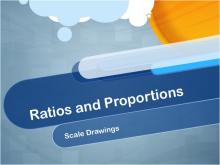
|
Closed Captioned Video: Ratios and Proportions: Scale Drawings | Closed Captioned Video: Ratios and Proportions: Scale DrawingsTopicRatios DescriptionThe video explains how proportions are used to create scale drawings, ensuring geometric figures remain proportional. Examples include finding dimensions in similar triangles, scaling architectural models, and solving geometric problems. The concept of proportional relationships is key to accurate scaling. |
Ratios and Rates |
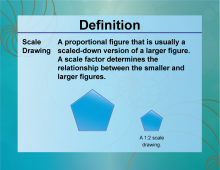
|
Definition--Ratios, Proportions, and Percents Concepts--Scale Drawing | Scale DrawingTopicRatios, Proportions, and Percents DefinitionA scale drawing is a representation of an object or structure with dimensions proportional to the actual object or structure. DescriptionScale drawings are essential in fields like architecture, engineering, and cartography, where accurate representations of large objects or areas are needed. For example, an architect might create a scale drawing of a building where 1 inch on the drawing represents 10 feet in reality. This allows for detailed planning and visualization without needing a full-sized model. |
Proportions |
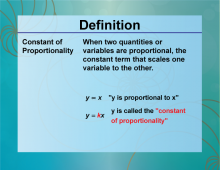
|
Definition--Ratios, Proportions, and Percents Concepts--The Constant of Proportionality | The Constant of ProportionalityTopicRatios, Proportions, and Percents DefinitionThe constant of proportionality is the constant value that relates two proportional quantities. DescriptionThe constant of proportionality is a fundamental concept in mathematics, particularly in linear relationships and direct variation. For example, in the equation y = kx, k is the constant of proportionality that relates y and x. This concept is crucial in fields like physics, where it is used to describe relationships such as speed (distance/time). |
Proportions |
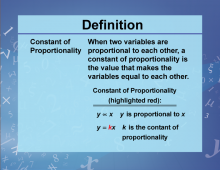
|
Definition--Variables, Unknowns, and Constants--Constant of Proportionality | Definition--Variables, Unknowns, and Constants--Constant of Proportionality
This is part of a collection of definitions related to variables, unknowns, and constants. This includes general definitions for variables, unknowns, and constants, as well as related terms that describe their properties. |
Variables and Unknowns |

|
Desmos Activity: Exploring Hooke's Law | Explore Hooke's Law using this Desmos graphing calculator activity. In this activity explore linear functions of the form y = mx. There is a companion worksheet for this activity, which subscribers can download. The worksheet is a PDF file. Related Resources To see additional resources on this topic click on the Related Resources tab above. Desmos Collection To see the complete collection of Desmos Resources click on this link. |
Graphs of Linear Functions and Proportions |

|
INSTRUCTIONAL RESOURCE: Activity Guide: Building a Scale Model of Himeji Castle | This hands-on activity is a companion to the video segment from the Geometry Applications: Angles and Planes video. In particular, it supports the segment on the architecture of Himeji Castle. Note: The download is a PDF file.Library of Instructional ResourcesTo see the complete library of Instructional Resources , click on this link. |
Applications of Angles and Planes, Applications of Transformations and Proportions |

|
Instructional Resource: Applications of Linear Functions: Hooke's Law | In this Slide Show, apply concepts of linear functions to the context of Hooke's law. Note: The download is a PPT file. Related ResourcesTo see the complete collection of Tutorials on this topic, click on this link: https://bit.ly/3g0P3cN |
Applications of Linear Functions and Proportions |

|
Lesson Plan--Ratios, Proportions, and Percents (Gr 7)--Lesson 3--Identifying Proportional Relationships | Lesson Plan: Identifying Proportional Relationships In this engaging Grade 7 math lesson, students will explore how to recognize and analyze proportional relationships. Using tables and graphs, learners will determine whether two quantities are proportional and identify the constant of proportionality. This lesson aligns with Common Core Standard 7.RP.A.2 and helps students build foundational skills in ratio and proportion concepts. Topics covered include: Recognizing proportional relationships in tables and graphsUnderstanding the constant of proportionalityIdentifying linear relationships that pass through the originSubscribers to Media4Math can download this lesson in PDF format for easy classroom use. |
Proportions and Applications of Linear Functions |

|
Lesson Plan--Ratios, Proportions, and Percents (Gr 7)--Lesson 4--Representing Proportional Relationships | Lesson Plan: Representing Proportional RelationshipsLesson SummaryIn this lesson, students will explore different ways to represent proportional relationships using tables, graphs, and equations. They will analyze proportional relationships in real-world contexts and learn how to determine the constant of proportionality. The lesson emphasizes how proportional relationships appear as linear functions that pass through the origin when graphed. Students will practice: |
Proportions |

|
Lesson Plan--Ratios, Proportions, and Percents (Gr 8)--Lesson 3--Graphing and Interpreting Proportional Relationships | Lesson Plan: Graphing and Interpreting Proportional Relationships In this lesson, students will explore how to represent and analyze proportional relationships using graphs, tables, and equations. They will learn that proportional relationships follow the equation \( y = kx \), where \( k \) is the constant of proportionality, and that these relationships always form a straight line passing through the origin on a coordinate plane. Key concepts covered in this lesson include: |
Applications of Ratios, Proportions, and Percents and Proportions |

|
Math Clip Art--Applications of Linear Functions: Hooke's Law 01 | Math Clip Art--Applications of Linear Functions: Hooke's Law 01TopicLinear Functions DescriptionThis image serves as the title card for a series of illustrations demonstrating applications of linear functions, specifically focusing on Hooke's Law. The series, comprising eight images, explores the relationship between force and displacement in springs, showcasing how linear models can represent real-world phenomena. |
Graphs of Linear Functions, Slope-Intercept Form and Proportions |
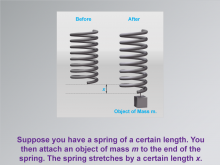
|
Math Clip Art--Applications of Linear Functions: Hooke's Law 02 | Math Clip Art--Applications of Linear Functions: Hooke's Law 02TopicLinear Functions DescriptionThis image is part of a series illustrating applications of linear functions, focusing on Hooke's Law. It depicts a spring before and after being stretched by a weight, visually representing the fundamental concept of Hooke's Law. The illustration shows a spring in its original state and then stretched by an object of mass m, extending by a length x. This visual representation helps students understand the relationship between the applied force (weight) and the resulting displacement of the spring, which forms the basis of the linear function in Hooke's Law. |
Graphs of Linear Functions, Slope-Intercept Form and Proportions |

|
Math Clip Art--Applications of Linear Functions: Hooke's Law 03 | Math Clip Art--Applications of Linear Functions: Hooke's Law 03TopicLinear Functions DescriptionThis image is a continuation of the series on applications of linear functions, specifically illustrating Hooke's Law. It builds upon the previous image by introducing the mathematical equation F(x) = kx, which is the core of Hooke's Law. The illustration shows that when a spring is stretched a distance x, a force F(x) is generated that is proportional to x. This visual representation, combined with the equation, helps students understand the linear relationship between force and displacement in springs. |
Graphs of Linear Functions, Slope-Intercept Form and Proportions |
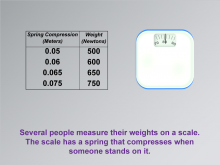
|
Math Clip Art--Applications of Linear Functions: Hooke's Law 04 | Math Clip Art--Applications of Linear Functions: Hooke's Law 04TopicLinear Functions DescriptionThis image is part of a series demonstrating applications of linear functions, focusing on Hooke's Law. It presents a practical application of the law by showing a data table alongside a weight scale, illustrating how Hooke's Law applies to everyday objects. |
Graphs of Linear Functions, Slope-Intercept Form and Proportions |
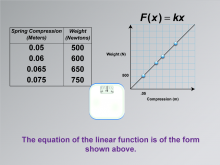
|
Math Clip Art--Applications of Linear Functions: Hooke's Law 06 | Math Clip Art--Applications of Linear Functions: Hooke's Law 06TopicLinear Functions DescriptionThis image is part of a series demonstrating applications of linear functions, specifically focusing on Hooke's Law. It builds upon the previous images by introducing the general form of the linear function equation that describes the relationship observed in the weight scale experiment. |
Graphs of Linear Functions, Slope-Intercept Form and Proportions |

|
Math Clip Art--Applications of Linear Functions: Hooke's Law 07 | Math Clip Art--Applications of Linear Functions: Hooke's Law 07TopicLinear Functions DescriptionThis image is part of a series illustrating applications of linear functions, focusing on Hooke's Law. It builds upon previous images by demonstrating how to calculate the spring constant 'k' using the data collected from the weight scale experiment. Note: Here is the link to the video referenced: https://www.media4math.com/library/42143/asset-preview |
Graphs of Linear Functions, Slope-Intercept Form and Proportions |
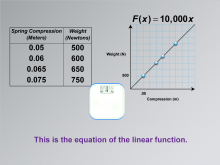
|
Math Clip Art--Applications of Linear Functions: Hooke's Law 08 | Math Clip Art--Applications of Linear Functions: Hooke's Law 08TopicLinear Functions DescriptionThis image represents the culmination of our exploration into applications of linear functions, specifically focusing on Hooke's Law. It serves as the final piece in a series of eight images, tying together all the concepts we've examined throughout this study of spring behavior and weight measurement. |
Graphs of Linear Functions, Slope-Intercept Form and Proportions |
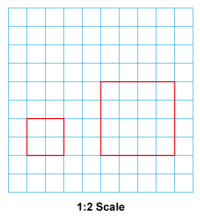
|
Math Clip Art--Geometry Concepts--Scale Drawing--01 | Math Clip Art--Scale Drawing--01TopicGeometry Concepts DescriptionThis image depicts a scale drawing of a square that has been scaled up by a factor of 1:2. This means that each side of the square in the drawing is twice the length of the corresponding side in the actual object. Scale drawings are essential for accurately representing objects in a manageable size while maintaining proportionality. Teacher's Script: "Observe this scale drawing of a square. How does the 1:2 scale factor help us understand the relationship between the drawing and the actual square? What are some real-world applications of scaling up objects, such as in architecture or design?" |
Proportions |
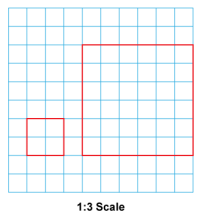
|
Math Clip Art--Geometry Concepts--Scale Drawing--02 | Math Clip Art--Scale Drawing--02TopicGeometry Concepts DescriptionThis image illustrates a scale drawing of a square that has been scaled up by a factor of 1:3. Each side of the square in the drawing is three times the length of the corresponding side in the actual object. This scaling helps in visualizing larger versions of objects while maintaining accurate proportions. Teacher's Script: "Look at this scale drawing of a square. How does the 1:3 scale factor affect the dimensions of the drawing compared to the actual square? What are some mathematical concepts you can explore using scale drawings, such as ratios or proportions?" |
Proportions |

|
Math Clip Art--Geometry Concepts--Scale Drawing--03 | Math Clip Art--Scale Drawing--03TopicGeometry Concepts DescriptionThis image shows a scale drawing of a rectangle that has been scaled up by a factor of 1:4. Each side of the rectangle in the drawing is four times the length of the corresponding side in the actual object. This scaling is useful for enlarging objects while maintaining their proportional dimensions. Teacher's Script: "Examine this scale drawing of a rectangle. How does the 1:4 scale factor influence the size of the drawing compared to the actual rectangle? What are some real-world applications of scaling up objects, such as in engineering or construction?" |
Proportions |
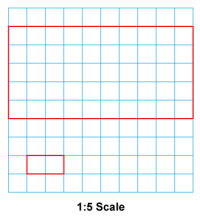
|
Math Clip Art--Geometry Concepts--Scale Drawing--04 | Math Clip Art--Scale Drawing--04TopicGeometry Concepts DescriptionThis image illustrates a scale drawing of a rectangle that has been scaled up by a factor of 1:5. Each side of the rectangle in the drawing is five times the length of the corresponding side in the actual object. Scale drawings like this are crucial for visualizing larger versions of objects while maintaining accurate proportions. Teacher's Script: "Observe this scale drawing of a rectangle. How does the 1:5 scale factor affect the dimensions of the drawing compared to the actual rectangle? What are some mathematical concepts you can explore using scale drawings, such as ratios or proportions?" |
Proportions |
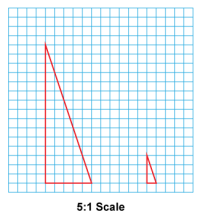
|
Math Clip Art--Geometry Concepts--Scale Drawing--05 | Math Clip Art--Scale Drawing--05TopicGeometry Concepts DescriptionThis image depicts a scale drawing of a right triangle that has been scaled down by a factor of 5:1. This means each side of the triangle in the drawing is one-fifth the length of the corresponding side in the actual object. Scaling down is useful for creating manageable representations of larger objects. Teacher's Script: "Examine this scale drawing of a right triangle. How does the 5:1 scale factor help us understand the relationship between the drawing and the actual triangle? What are some real-world applications of scaling down objects, such as in model making or map creation?" |
Proportions |
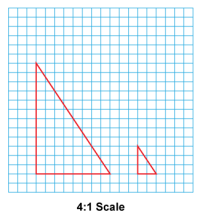
|
Math Clip Art--Geometry Concepts--Scale Drawing--06 | Math Clip Art--Scale Drawing--06TopicGeometry Concepts DescriptionThis image illustrates a scale drawing of a right triangle that has been scaled down by a factor of 4:1. Each side of the triangle in the drawing is one-fourth the length of the corresponding side in the actual object. This scaling helps in visualizing smaller versions of objects while maintaining accurate proportions. Teacher's Script: "Observe this scale drawing of a right triangle. How does the 4:1 scale factor affect the dimensions of the drawing compared to the actual triangle? What are some mathematical concepts you can explore using scale drawings, such as ratios or proportions?" |
Proportions |
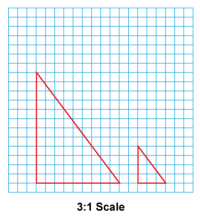
|
Math Clip Art--Geometry Concepts--Scale Drawing--07 | Math Clip Art--Scale Drawing--07TopicGeometry Concepts DescriptionThis image depicts a scale drawing of a right triangle that has been scaled down by a factor of 3:1. Each side of the triangle in the drawing is one-third the length of the corresponding side in the actual object. Scaling down is useful for creating manageable representations of larger objects. Teacher's Script: "Examine this scale drawing of a right triangle. How does the 3:1 scale factor help us understand the relationship between the drawing and the actual triangle? What are some real-world applications of scaling down objects, such as in model making or map creation?" |
Proportions |
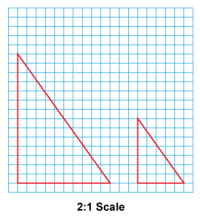
|
Math Clip Art--Geometry Concepts--Scale Drawing--08 | Math Clip Art--Scale Drawing--08TopicGeometry Concepts DescriptionThis image illustrates a scale drawing of a right triangle that has been scaled down by a factor of 2:1. Each side of the triangle in the drawing is one-half the length of the corresponding side in the actual object. This scaling helps in visualizing smaller versions of objects while maintaining accurate proportions. Teacher's Script: "Observe this scale drawing of a right triangle. How does the 2:1 scale factor affect the dimensions of the drawing compared to the actual triangle? What are some mathematical concepts you can explore using scale drawings, such as ratios or proportions?" |
Proportions |

|
Math Clip Art--Ratios, Proportions, Percents--Scale Drawings and Scale Models 01 | Math Clip Art--Ratios, Proportions, Percents--Scale Drawings and Scale Models 01
This is part of a collection of math clip art images that explain different aspects of ratios, proportions, and percents. |
Proportions |
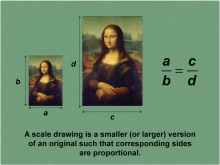
|
Math Clip Art--Ratios, Proportions, Percents--Scale Drawings and Scale Models 02 | Math Clip Art--Ratios, Proportions, Percents--Scale Drawings and Scale Models 02
This is part of a collection of math clip art images that explain different aspects of ratios, proportions, and percents. |
Proportions |
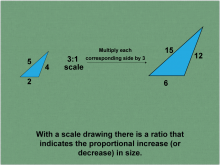
|
Math Clip Art--Ratios, Proportions, Percents--Scale Drawings and Scale Models 03 | Math Clip Art--Ratios, Proportions, Percents--Scale Drawings and Scale Models 03
This is part of a collection of math clip art images that explain different aspects of ratios, proportions, and percents. |
Proportions |

|
Math Clip Art--Ratios, Proportions, Percents--Scale Drawings and Scale Models 04 | Math Clip Art--Ratios, Proportions, Percents--Scale Drawings and Scale Models 04
This is part of a collection of math clip art images that explain different aspects of ratios, proportions, and percents. |
Proportions |
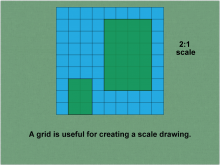
|
Math Clip Art--Ratios, Proportions, Percents--Scale Drawings and Scale Models 05 | Math Clip Art--Ratios, Proportions, Percents--Scale Drawings and Scale Models 05
This is part of a collection of math clip art images that explain different aspects of ratios, proportions, and percents. |
Proportions |
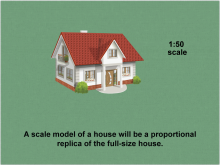
|
Math Clip Art--Ratios, Proportions, Percents--Scale Drawings and Scale Models 06 | Math Clip Art--Ratios, Proportions, Percents--Scale Drawings and Scale Models 06
This is part of a collection of math clip art images that explain different aspects of ratios, proportions, and percents. |
Proportions |

|
Video Transcript: Ratios and Proportions: Scale Drawings | Video Transcript: Ratios and Proportions: Scale Drawings
This is the transcript that goes with the video segment entitled Video Tutorial: Ratios and Proportions: Scale Drawings. This is part of a collection of video transcripts for the video tutorial series on Ratios. To see the complete collection of transcripts, click on this link. Note: The download is a PDF file. Video Transcript LibraryTo see the complete collection of video transcriptsy, click on this link. Video LibraryTo see the complete collection of videos in the Video Library, click on this link. |
Ratios and Rates |

|
Video Tutorial: Hooke's Law | Video Tutorial: Hooke's Law
This YouTube video describes Hooke's Law, which is an application of linear functions of the form y = kx. |
Slope-Intercept Form and Proportions |